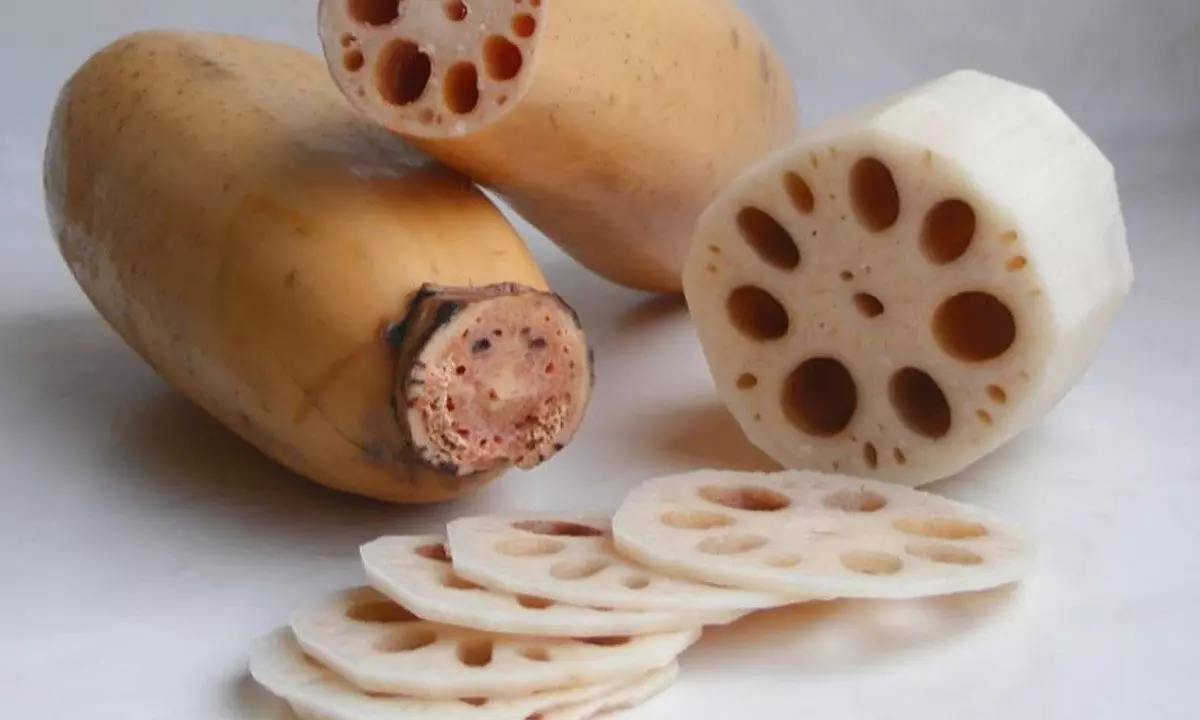Health Benefits of Lotus Roots/Kamal kakri

Health Benefits of Lotus Roots/Kamal kakri
Lotus roots are also known as Kamal Kakri, they are woody, and they are edible root, which can reach a length of about 4 feet. It is a type of acquatic root vegetable, which resembles long squash in shape.
Lotus roots are also known as Kamal Kakri, they are woody, and they are edible root, which can reach a length of about 4 feet. It is a type of acquatic root vegetable, which resembles long squash in shape.
Lotus root is an edible vegetable, it has crisp texture, and it has got mild sweet flavor, it has got less number of calories and free of cholesterol. A special combination of vitamins, minerals and nutrients found in lotus root is extremely beneficial to our bodies.
Potassium, phosphorus, copper, iron and manganese are the minerals and vitamins found in lotus root, along with thiamine, pantothenic acid, zinc, Vitamin B6 and Vitamin C. Additionally, the lotus root is a significant source of protein as well as nutritional fibre.
How to include Lotus roots in your Diet?
Lotus roots are commonly pickled as a snack and it is included in dishes with prawns. It has got tangy and slightly sweet taste. It is often used as salad topping. It has the texture of a potato and tastes slightly like coconuts before any extra flavouring is added,
Health Benefits of Lotus Root
Nutritional Value
Lotus root is full of rich nutritional value, if you are considering to incorporate essential vitamins and minerals in your diet, lotus root is a wonderful edition. It is rich source of Vitamin C, providing 73% of the daily recommended value. Vitamin C is a Vital element of a healthy diet, because it helps support overall health as well as numerous functions of the body. Getting enough Vitamin C helps boost your body's immune system by protecting it against varied viral infections and also help protect your body against free radicals.
Helps increase Blood Circulation
Lotus root help improve blood circulation, thus ensuring all the organs in the body are properly oxygenated. When your organs receive adequate oxygen, they run a lot smoother and do a better job of keeping your body up and running, while giving you an energy boost. Rich in copper and iron, Lotus roots also encourages the production of red blood cells, thus preventing symptoms of anemia from popping up.
Regulates blood Pressure
Lotus root contains sodium and potassium. When these two elements work together, they tend to help maintain healthy blood pressure levels. Potassium and sodium have a sort of yin and yang effect.
Maintain heart health
Lotus roots help increase blood circulation and regulates the blood pressure, it should come as no surprise that eating lotus root might help improve your cardiovascular health. The fiber content of lotus root also help reduce LDL cholesterol levels, which can clog arteries and lead to such problems as hart attack, stroke and heart disease.
Improves Digestion
Lotus root is loaded with dietary fiber, which helps to keep things regular and moving smoothly. Getting enough fiber helps to add bulk to stool and encourages bowel movements, helping to prevent constipation. Adding bulk to stools also help prevent the development of diarrhoea.
Encourage Mental Balance
Lotus root contains the B-vitamin Pyridoxine. Pyridoxine is known to increase your sense of well-being and inspire mental stability. Pyridoxine works directly with the neural receptors that dictate your mental state and the mood. These receptors also influence stress levels and headaches.
Protects your Eye health
Lotus root contains a significant amount of Vitamin A, which is important to maintain your vision while preventing macular degeneration.
Beautifies Your Complexion
Lotus root is rich in Vitamin C, which encourages the development of collagen, essential to maintaining the skin's structure and preventing the development of age spots and fine lines. Collagen helps keep your skin looking supple and smooth, while preventing the sagging and dullness.















